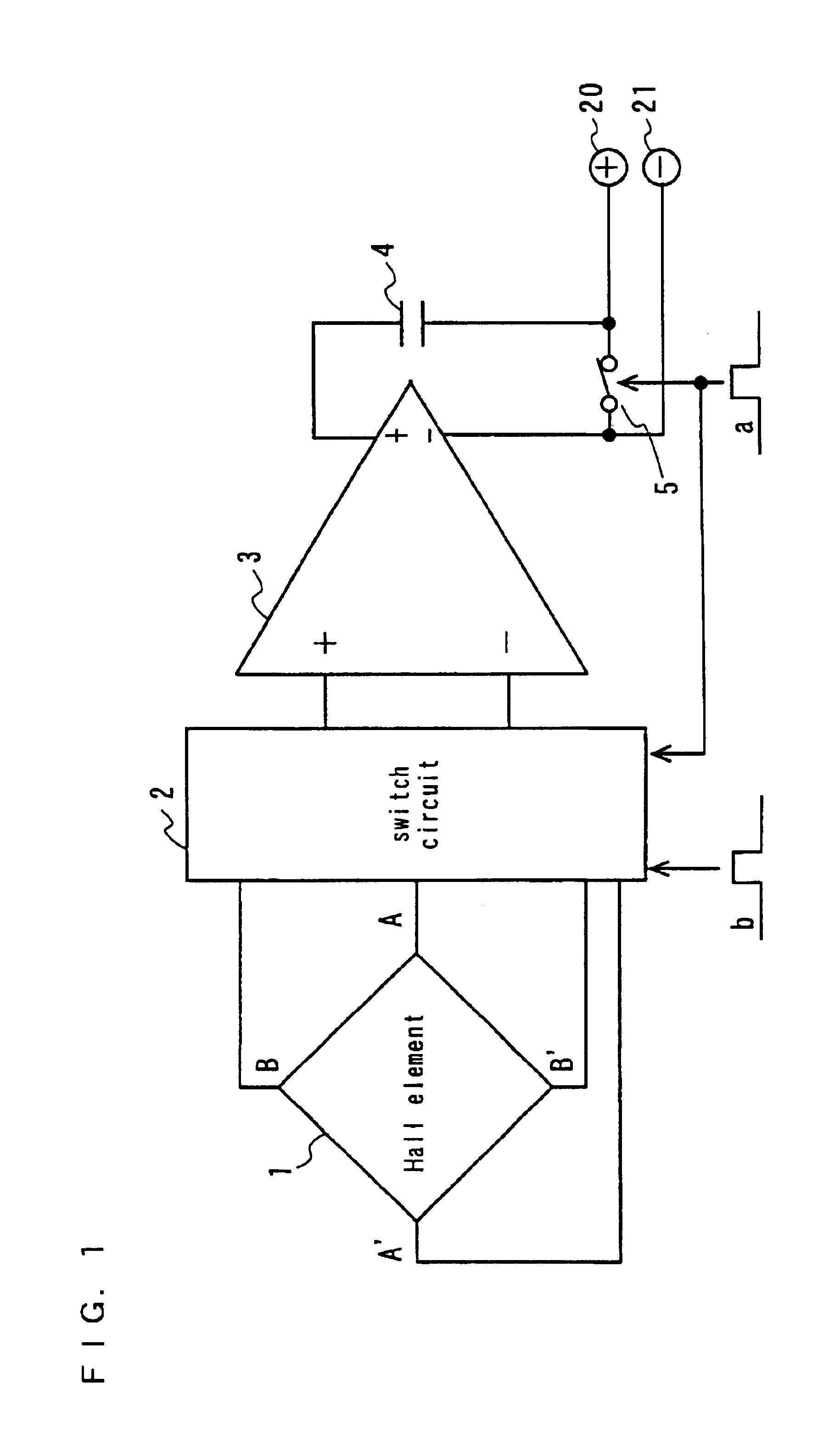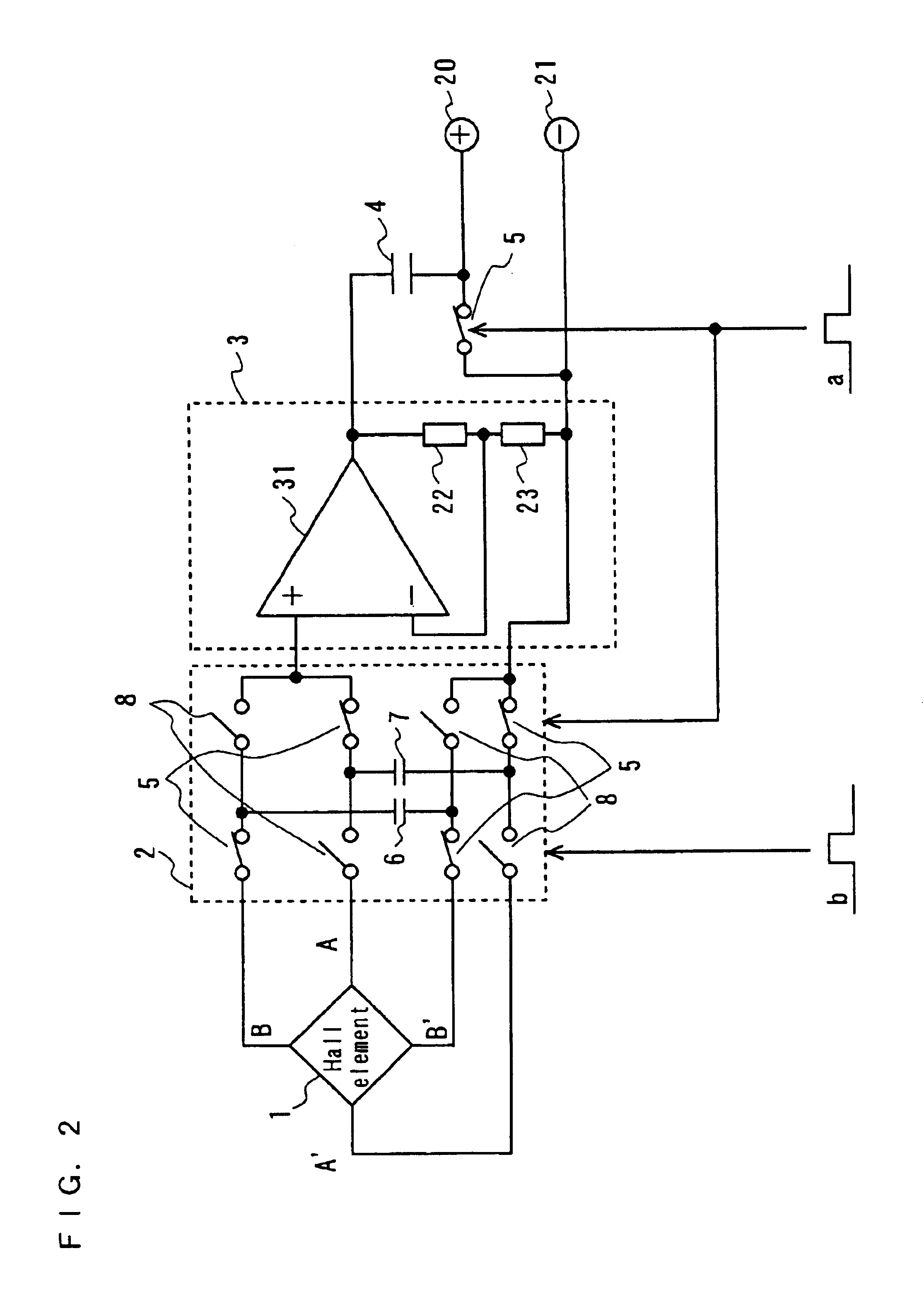Magnetic field sensor
a magnetic field sensor and sensor technology, applied in the field can solve the problems of large chip area occupied by output parts, large circuit scale for cancelling input offset voltage, and large consumption current reduction of magnetic field sensors, etc., and achieve the effect of large gain of voltage amplifiers
- Summary
- Abstract
- Description
- Claims
- Application Information
AI Technical Summary
Benefits of technology
Problems solved by technology
Method used
Image
Examples
embodiment 1
<<Embodiment 1>>
FIG. 1 shows a configuration of a magnetic field sensor according to the first embodiment of the present invention. In FIG. 1, a Hall element is denoted as 1, a switch circuit is denoted as 2, a voltage amplifier is denoted as 3, a capacitor which is a memory element is denoted as 4 and a switch is denoted as 5.
The Hall element 1 is a Hall element in a plate form with four terminals, and the form of the Hall element 1 is geometrically equivalent.
The first phase signal (a) that has a pulse in the first phase is given to the switch 5 and the switch circuit 2. The second phase signal (b) that has a pulse in the second phase is given to the switch circuit 2.
The timing chart in the first embodiment is shown in FIG. 7.
With respect to the magnetic field sensor constructed as the above, the operation is described in the following.
The operation of the first phase is described.
In the first phase, the switch 5 is closed.
At this time, a power source voltage is applied ...
embodiment 2
<<Embodiment 2>>
FIG. 2 shows a configuration of a magnetic field sensor according to the second embodiment of the present invention. In FIG. 2 a Hall element is denoted as 1, a switch circuit is denoted as 2, a voltage amplifier is denoted as 3, capacitors which are memory elements are denoted as 4, 6 and 7, and switches are denoted as 5 and 8.
The Hall element 1 is a Hall element in a plate form with four terminals, and the form of the Hall element 1 is geometrically equivalent.
The voltage amplifier 3 is formed of a single input amplifier and two resistances 22, 23 which define the amplification factor (feed back amount). This is the same as the voltage amplifier 3 of the first embodiment with respect to the function which outputs a voltage proportional to the input voltage.
In the first phase, the first phase signal (a) which has a pulse is given to the switch 5 (including the switch 5 which forms a part of the switch circuit 2) and a changing switch of a circuit which app...
embodiment 3
<<Embodiment 3>>
FIG. 3 illustrates a magnetic field sensor of the third embodiment which uses the magnetic field sensor of the first embodiment according to the present invention. The magnetic field sensor of the third embodiment outputs a binary digital signal of 0 or 1 in accordance with the intensity of the magnetic field.
In FIG. 3, a Hall element is denoted as 1, a switch circuit is denoted as 2, a voltage amplifier is denoted as 3, a capacitor which is a memory element is denoted as 4, a switch (which is closed in the first phase and is open in the other phase) is denoted as 5, a comparator is denoted as 13, a latch circuit is denoted as 14, a clock generation circuit is denoted as 15, the first phase clock generation circuit is denoted as 16 and the second phase clock generation circuit is denoted as 17.
The Hall element 1 has a plate form with four terminals, and the form of the Hall element 1 is geometrically equivalent.
(a) in FIG. 7 shows a waveform (including the ...
PUM
 Login to View More
Login to View More Abstract
Description
Claims
Application Information
 Login to View More
Login to View More - R&D
- Intellectual Property
- Life Sciences
- Materials
- Tech Scout
- Unparalleled Data Quality
- Higher Quality Content
- 60% Fewer Hallucinations
Browse by: Latest US Patents, China's latest patents, Technical Efficacy Thesaurus, Application Domain, Technology Topic, Popular Technical Reports.
© 2025 PatSnap. All rights reserved.Legal|Privacy policy|Modern Slavery Act Transparency Statement|Sitemap|About US| Contact US: help@patsnap.com



